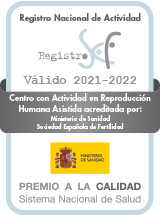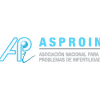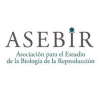The ROPA method is one of the most innovative techniques and increasingly used today by couples of women who want to be mothers together. This technique emerges as an alternative to artificial insemination with a donor, which was the method used a few years ago for female homosexual couples.
The ROPA Method, also known as “shared maternity”, consists of carrying out an IVF/ICSI cycle in which the two women will be involved, one providing the oocytes and the other woman, carrying in her womb the resulting embryo. In the first place, one of the women of the couple undergoes a stimulation and ovarian puncture from where we will obtain the oocytes. On the same day of the ovarian puncture, the oocytes will be inseminated with the IVF or ICSI technique in assisted reproduction laboratories with a seminal donor sample. The embryos formed will be transferred to the uterus of the other woman of the couple, who will have carried a personalized endometrial preparation to guarantee implantation.
Who is it for?
This technique is ideal for couples of women who want to face the path of motherhood together. It is ideal for couples of women who want to be mothers equally.
How is the proccess?
The process of in vitro fertilization in the ROPA method is carried out in several phases but is completely outpatient. That is to say, that the treatment will be carried out entirely in the consultation and you will not have to stay entered. This process will involve the two women of the couple, but this will not hinder the treatment.
Surely you will be interested to know where we would start in case you submit to an in vitro fertilization, so we want to explain the steps of the process to make it more familiar, just to inform, since in any case you will have us at your side to guide you in each stage of the process and to solve any doubt, however small, that you may have.

The first step of the treatment would be to introduce hormones to the woman who wishes to donate the oocytes to her partner, that is, to the one that wishes to provide the ovules to be fertilized. With these hormones we will increase the development of your eggs. During this first phase of treatment, you will be monitored by ultrasound and blood tests to check hormone levels. Once the results of the tests advise it, it will be time to proceed to the extraction of the ovules.
The puncture of the ovules is done through aspiration with ultrasound to guide the selection of ovules. This process does not require anesthesia, but we will use gentle sedation. As we have mentioned, it is a completely outpatient process. It is not painful, although it can be annoying. Once the ovules are extracted, the best quality ones are selected and they are joined together with the semen in the laboratory in order to achieve fertilization.
The transfer of embryos, that is, the introduction of the embryos into the uterus, will be done to your partner, between day 3 or day 5 of embryo development. She will be the pregnant of the transferred embryos, in this way you are both involved in this process. It is a process that involves the introduction of a catheter that contains the embryos inside the vagina to place the embryos in the uterus. If the embryo is implanted in the lining of the uterus and develops, it is when a pregnancy occurs.
In collaboration with the doctor, you will have to decide if you want the transfer of only one embryo or two. With two embryos the possibilities are multiplied, but you will also have to consider in this case the multiple pregnancy option. Currently, and according to Spanish legislation, the implantation of more than 3 embryos is not allowed. The current trend is not to transfer more than two embryos and you should also know that, thanks to the latest advances in assisted reproduction, it is possible to achieve pregnancy with the implantation of a single embryo selected (the best) and avoid multiple pregnancy.
After the intervention, the expectant mother must continue with the hormonal medication to help the implantation of the embryo. The hormone that will be administered to you is called progesterone and its goal is to help thicken the lining of the uterus.
Approximately 12 to 14 days after the embryo transfer, you will already be able to undergo a pregnancy test in blood to confirm if the treatment has been successful and there is pregnancy.

What are the chances of success for IVF?
We do not like to talk about numbers or statistics, because we believe that each case is unique. But we also believe that you must have all the necessary information so that you can take into account that nobody is in a position to guarantee that pregnancy you wish.
Our commitment is to help, guide and support you to offer you the best alternative and the best chance of success, but as much as we would like, absolute guarantees do not exist when we talk about assisted reproduction and we want to be very honest with this.
The chances of success will depend on different factors beyond the treatment itself. From there, and to give you a rough idea, according to the data of the Society of Assisted Reproduction Technology (SART), the possibility of giving birth to a baby after an IVF treatment is:
- 41-43% for women under 35 years
- 33-36% for women aged 35-37
- 23-27% for women between 38 to 40
- 13-18% for women over 41 years
In the case that after a first IVF treatment there is no pregnancy, a second cycle can be carried out and up to a third one. We do not recommend more than three.
- Emotional stress
- Side effects related to medication and ovarian hyperstimulation syndrome (OHSS), such as abdominal pain, swelling, fluid retention, nausea or vomiting
- The risk of infection and bleeding during the extraction of the ovules
- The risk of multiple pregnancies depending on the number of embryos transferred. This can lead to premature delivery and low birth weight of the child.
However, you will be constantly supervised throughout the process to support you both physically and emotionally and inform you about everything you need.
OUR TREATMENTS
OR-Ovarian Rejuvenation
It is a revolutionary technique that involves the reactivation of stem cells and the remaining follicles in the ovary.
IA – Artificial Insemination
It is an assisted reproduction technique that will help you get pregnant easily and safely.
IVF – In vitro fertilization
It is the union of the ovum with the sperm in the laboratory, in order to obtain embryos already fertilized to transfer to the maternal uterus and achieve a pregnancy.
Egg Donation
Fertility treatment that consists of performing an In Vitro Fertilization with anonymous donor eggs. If necessary, this egg is fertilized with semen from the partner or another donor.
Genetic diagnosis
It refers specifically to the technique used in the event that one or both parents have a genetic abnormality. The embryo is analyzed to determine if it carries the same genetic abnormality.
ROPA Method
It consists of an In Vitro Fertilization treatment shared between both women, that is, one woman is the donor of the egg, while the other woman is the pregnant woman of the embryo.
Request your free appointment
Official Certificates
National Registry of the Spanish Fertility Society








